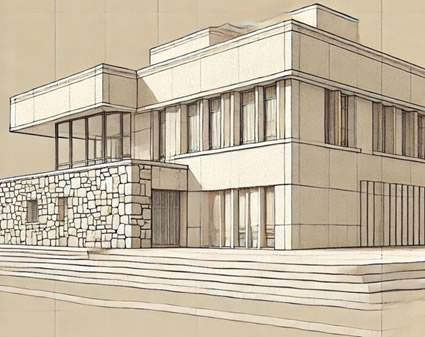In the intricate dance of bringing architectural visions to life, the alignment between design and execution is paramount. At the heart of this alignment lies an often underappreciated aspect of architectural planning—adherence to local construction best practices. This piece delves into the essence of best practices, elucidating how local contractors’ skills, experiences, and comfort zones significantly influence the success of a project. It underscores the importance of architects being attuned to the local trade practices to ensure project success for the owner.
Local contractors operate within a realm of expertise honed by years of experience in their specific geographic and cultural context. Their familiarity with local materials, construction techniques, and environmental considerations form the backbone of efficient and effective construction practices. For architects, tapping into this wealth of local knowledge is not just beneficial; it’s imperative for the seamless realization of their designs.
The practice of adapting architectural designs to suit local best practices is not a new concept. A quintessential example is Le Corbusier’s approach to the Villa de Mandrot in France. Understanding the limitations of the local tradesmen in a remote locale on the French coast, Le Corbusier intentionally simplified his design. Instead of insisting on complex feats of concrete and glass that characterized his other works, he opted for a design that local craftsmen could successfully execute. This strategic adaptation ensured the project’s success, maintaining high design standards while accommodating local skills.

Architects should also be mindful that regional distinctions of construction are found in different localities. Architects must consider the availability and appropriateness of local materials in their designs. In Hawaii, for example, lava rock is a prevalent and economically viable material for site walls, reflecting local availability and construction expertise. Its use not only leverages local resources but also integrates the built environment with its natural surroundings, contributing to a sense of place and identity.
In contrast, the cold climates of New Hampshire or Vermont present a different set of considerations. Here, rock and timber are plentiful, and the primary concern shifts to insulation and heating efficiency. Local contractors are well-versed in the use of these materials and the construction techniques required to meet the thermal demands of the environment. Architects designing for these regions must prioritize these considerations, drawing on local expertise to achieve both aesthetic and functional objectives. When designing the same site wall in New Hampshire vs. Hawaii, the designer may consider using granite rock because of its ample availability.

The Southwest U.S. offers yet another paradigm, where timber is scarce, and the climate poses challenges of heat and water scarcity. Here, best practices revolve around the use of materials such as adobe and concrete, which are better suited to the environmental conditions. Local contractors are adept at employing these materials in ways that maximize cooling and minimize water use, aligning with sustainable design principles. When designing in Arizona, unlike Hawaii or New Hampshire, the designer may consider using sand and stone for the site wall. It would not follow the local custom to choose stucco in New Hampshire, stone for Hawaii, and lava rock in Arizona. Stucco is rather unsuited for colder climates, and New Hampshire has ample amounts of natural stone. Importing stone to Hawaii is an expensive undertaking when lava rock is abundant. Arizona has plenty of sand and stone for concrete block and stucco, so there is no need to ship lava rock from Hawaii.

The above examples do not suggest that the architect cannot design outside the common practices of an area. Rather, the key point is to illustrate that it is helpful for an architect to remain aware of the best practices in a local industry. Architects should always be aware of local builders and their standard methods when preparing their designs. If the architect decides to design outside of the local standards, the architect’s drawings should be particularly clear, and they should include extra details and specifications. One may struggle to get local contractors to work with materials and techniques foreign to that locale.
Best practices, therefore, are not merely guidelines but reflections of the collective wisdom of local construction communities. They represent the optimal integration of design with local capabilities, materials, and environmental considerations. For architects, embracing these practices means recognizing that successful architecture is not imposed but rather grows from the local context. It involves a collaborative process where the architect’s vision is realized through the lens of local expertise, ensuring that the final structure is not only a testament to design excellence but also a functional, sustainable, and integral part of the local landscape.
In sum, acknowledging and incorporating local construction best practices into architectural designs is crucial for the success of any project. It demands a deep understanding of local contexts, a respect for the skills and knowledge of local contractors, and a commitment to designing buildings that are both beautiful and deeply rooted in their specific locale. This approach not only enhances project success but also fosters a sense of community and belonging, marking the true essence of thoughtful and responsive architecture.
 To read more by Christopher D. Ling, AIA, purchase a copy of his book The Architect's Standard of Care on Amazon.com.
To read more by Christopher D. Ling, AIA, purchase a copy of his book The Architect's Standard of Care on Amazon.com.
Christopher D. Ling, IA, NCARB, PP, LEED AP, is a Forensic Architect with extensive experience in construction litigation, risk management, and architectural design. He specializes in analyzing and resolving complex construction disputes, having written reports for over 1,000 cases involving $1 billion in claims. He has testified in mediations, arbitrations, and federal court cases. He has an ability to distill and communicate intricate design and construction issues clearly has been instrumental in mediation, arbitration, and court proceedings. He has a hands-on approach to conducting physical inspections, preparing expert reports, and analyzing construction claims, which further solidifies my qualifications.
©Copyright - All Rights Reserved
DO NOT REPRODUCE WITHOUT WRITTEN PERMISSION BY AUTHOR.






 To read more by Christopher D. Ling, AIA, purchase a copy of his book
To read more by Christopher D. Ling, AIA, purchase a copy of his book 





